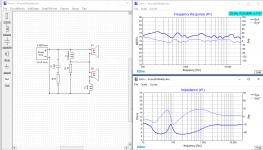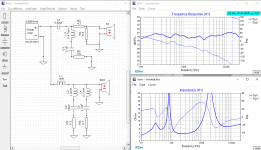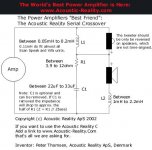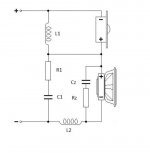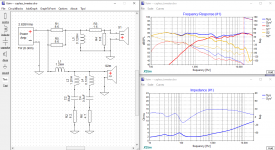Has anyone tried this xover before? Here is the link:
AR-SXO - Acoustic Reality - Designed and built in Denmark

I did a simple simulation and it does surprisingly well. The downside is the low frequencies are not quite as efficient because some of the current will run through the resistor instead of the woofer. So the bass won't sound as dynamic.
The positive is it does not need a capacitor, but it will stress the tweeter more so you need some quality tweeter.
Here are two simulations: one with acoustic reality and one with a more conventional approach. The conventional approach is about 1.5dB more at the low frequencies vs. acoustic reality.
AR-SXO - Acoustic Reality - Designed and built in Denmark

I did a simple simulation and it does surprisingly well. The downside is the low frequencies are not quite as efficient because some of the current will run through the resistor instead of the woofer. So the bass won't sound as dynamic.
The positive is it does not need a capacitor, but it will stress the tweeter more so you need some quality tweeter.
Here are two simulations: one with acoustic reality and one with a more conventional approach. The conventional approach is about 1.5dB more at the low frequencies vs. acoustic reality.
Attachments
Used the cap version of the AR crossover for ages and in most of my better speakers. Very easy to use and tune but driver selection can be important.
Adding a CR across the woofer not only helps impedance correction but also shaping of woofer roll off and getting great phase results over the crossover area.
Adding a CR across the woofer not only helps impedance correction but also shaping of woofer roll off and getting great phase results over the crossover area.
Attachments
When you use C1, it means C1 will be in the tweeter signal path, which defeats the purpose of a "capless" xover, does it not?
The inclusion of C1 does solve the problem of current flowing through R1. But now the tweeter phase has to be inverted.
The inclusion of C1 does solve the problem of current flowing through R1. But now the tweeter phase has to be inverted.
Attachments
Last edited:
Now, if you really want to use "capless" xover for the tweeter, but still want to run a more conventional parallel xover, you can try something like these. The advantage of the parallel xover is you won't lose any efficiency on the bass.
The nice thing about this approach is you can extend it to a three-way xover if you want. With the Acoustic Reality xover, adding a woofer will be somewhat complicated.
The nice thing about this approach is you can extend it to a three-way xover if you want. With the Acoustic Reality xover, adding a woofer will be somewhat complicated.
Attachments
Last edited:
I don't advise the capless AR, as it kills the woofer sensitivity.
Ditto on both being a fire-hazard, the AR and your parallel, where the resistors become VERY HOT.
You should also check your impedances, Andy- the capless AR is almost a dead-short, and your parallel is a 2 ohm load.
Later,
Wolf
Ditto on both being a fire-hazard, the AR and your parallel, where the resistors become VERY HOT.
You should also check your impedances, Andy- the capless AR is almost a dead-short, and your parallel is a 2 ohm load.
Later,
Wolf
What you said is true so if anyone who wants to try it, has to be very careful.
As for the parallel capless version, the resistor can be three-in-parallel which helps to dissipate the heat. This version of capless xover has been used in Sonus Faber speakers.
As for the parallel capless version, the resistor can be three-in-parallel which helps to dissipate the heat. This version of capless xover has been used in Sonus Faber speakers.
Last edited:
The RL on the tweeter works well. DCR shouldn't be too high to continue the rolloff down lower.
Though it reduces the impedance peak, I think that is only of interest for those that want to appear to do more with less. After all, we'd probably consider a filter for the peak. Even though there is a capacitor in it there is so much in series with it, and it is all shunted by the main inductor.
Though it reduces the impedance peak, I think that is only of interest for those that want to appear to do more with less. After all, we'd probably consider a filter for the peak. Even though there is a capacitor in it there is so much in series with it, and it is all shunted by the main inductor.
How so?it will stress the tweeter more
The original AR inherently crosses the tweeter at fairly low frequency. The modified version which has the C1 cap in series with the tweeter can move the xover point slightly higher in the frequency range but then it would defeat the purpose of a "capless" filter.
Many things don't need to be eliminated per se, but have their effects reduced to be 'effectively eliminated'. This was my reasoning behind the C in the RLC, and begs further questions. Inductors are not necessarily easy to implement at line level, and capacitors become a compelling option.
- Home
- Loudspeakers
- Multi-Way
- Acoustic Reality series xover
